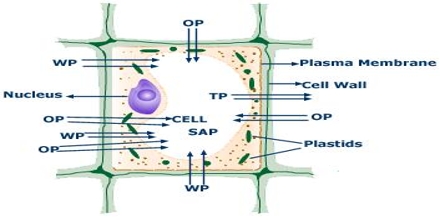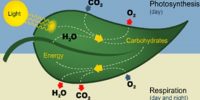Turgor pressure (T.P.) and Wall pressure (W.P.)
Turgor Pressure: The pressure that is exerted on the cell wall duel to turgidity is called Turgor pressure (T.P.). It is defined as the amount of pressure inside a cell solely due to its water content, whereas Osmotic Pressure is defined as the pressure required to stop osmotic flow between the cell and a pure solvent when the pressure exerted by water is zero. Plant cells need a certain amount of pressure to make sure that the cell wall stays rigid.
- This pressure is exerted on the cell wall due to the entry of water inside the cell. Plant cells are very much like your own cells, except they are surrounded by a cell wall.
- The turgor pressure is responsible for the growth and enlargement of the cell. It also keeps the stem erect and leaves expand.
- This pressure is exerted by the protoplast against the cell wall due to the entry of water is called pressure potential. As water fills the cells, it pushes against the cell membrane and cell wall, producing turgor pressure.
- This cell wall is part of what gives plants such a rigid and sturdy structure. The chemical composition of cell wall varies depending on the type of cell.
The water pressure inside plant cells is called turgor pressure, and it is maintained by a process called osmosis. Technically speaking, osmosis is the movement of water across a differentially permeable membrane from a place where water concentration is higher to one where the concentration is lower. Fungi, protists, bacteria, and plants all secrete various extracellular molecules form together to create a solid wall on the outside of their cells. It is the outer most boundaries of the plant cells.

Wall pressure (W.P.): The cell wall, when stretched fully (due to turgidity), also exerts a counter-pressure on the fluid contents of the cell is said to be the wall pressure. In turgid condition the turgor pressure equal to the wall pressure. Wall pressure is the pressure applied to the cell wall on the contents of the cell. The pressure exerted on the contents of a plant cell by the cell wall that is equal in force and opposite in direction to the turgor pressure.
- This process occurs in plants, bacteria, fungi, and protists to contain cell walls.
- The endosmosis ceases when the turgor pressure becomes equal to the wall pressure.
Relationship between Turgor Pressure and Wall Pressure
When a plant cell is positioned in pure water (hypotonic solution) the dispersion of water into the cell takes place by endosmosis. It creates an optimistic hydrostatic pressure on the rigid cell wall by the cell membrane. Hereafter the pressure exerted by the cell membrane towards the cell wall is Turgor Pressure (TP).
The cell wall reacts to this turgor pressure with equivalent and reverses force, and the counter-pressure exerted by the cell wall towards the cell membrane is wall pressure (WP).
Turgor pressure and wall pressure make the cell fully turgid. So, TP + WP = Turgid.














